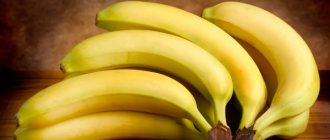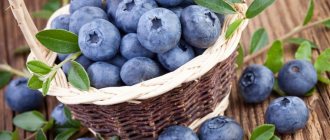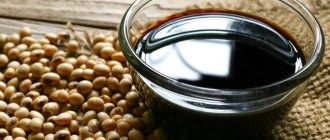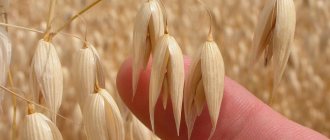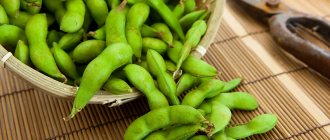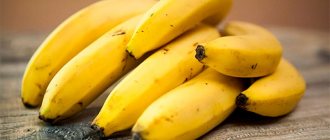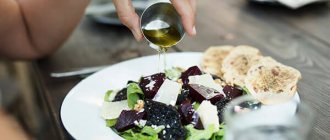The recognizable aromatic fruit, which can be found in any supermarket or market, comes from Southeast Asia. Its pulp is easily digestible, but the relatively high calorie content of banana is rejected by many in weight loss diets. In this article we will answer some questions, for example, how many calories are in a banana, whether these fruits can be used in weight loss diets. Let's talk in more detail about the nutritional value of the product and how many calories are in one medium banana. Let's compare how many kcal are in a banana per 100 grams without peel and per kilogram. And also - how many calories are in 100 grams of banana, based on the size and weight of the fruit.
Nutritional value of bananas (BJU)
In dietetics, one of the most important characteristics of the nutritional value of products is their ability to saturate the body with energy. It is determined by the amount of energy that a person receives when releasing food components during the process of digestion and assimilation. The abbreviation BZHU, or nutritional value, consists of three main elements, the content of which determines the energy value of the product. These are proteins-fats-carbohydrates.
The basis for calculating BZHU is 100 g of product (packaged or individually). In addition to the three elements, the energy value of the products is indicated in kJ, where 1 kcal is equal to 4.16 kJ, and also in kcal. Based on the BZHU, the daily calorie intake required for normal functioning and active human activity is calculated.
If we talk about banana BJU, then 100 g of ripe fruit pulp contains:
- proteins - 1.5 g;
- fat - 0.1 g;
- carbohydrates - 21.8 g;
- dietary fiber - 1.7 g.
When calculating BZHU, it is necessary to take into account the weight of the product.
The percentage of calorie content of a banana in 1 piece is proteins, fats, carbohydrates:
- proteins - 1.5%;
- fats - 0.5%;
- carbohydrates - up to 30%.
In addition to the importance of the question of how many kilocalories are in a banana, we also note the presence of 42 mg of magnesium and about 350 mg of potassium. Thanks to the combination of these elements, fruits quickly restore energy and vitality as a snack between meals. Considering the average calorie content in 1 piece of banana, it should be noted that it is able to compensate for the daily requirement of magnesium and potassium. Which, in turn, can be used to prevent myocardial infarction.
Another 100 g contains:
- vitamin A, provitamin A - approximately 2% of the daily requirement;
- beta-carotene is found more in red platano varieties, that is, vegetable varieties of the fruit;
- B vitamins, very important for muscle function, cholesterol removal and preventing the development of diabetes;
- vitamin C - about 11% of the daily requirement;
- vitamins E, PP;
- manganese - 14% of daily intake, important for immunity and good mood;
- the amino acid tryptophan, used by the body in the production of serotonin;
- zinc, selenium, fluorine, iron.
So, simple carbohydrates, sucrose, predominate in the pulp, and the proportion of complex carbohydrates does not exceed 8%. The remainder of the mass (>65%) is water.
Chemical composition of banana
The fruits contain a large amount of useful substances. Their composition is perfectly balanced and includes many antioxidants.
The chemical composition of banana is characterized by a high content of vitamins.
Vitamins
The high content of vitamins allows the fruit crop to be classified as a valuable food product.
Includes:
| Vitamins | Content per 100 g, mg | Daily requirement, mg |
| WITH | 8,7-10 | 60 |
| IN 1 | 0,05 | 1,5-2 |
| AT 2 | 0,05 | 2-2,5 |
| AT 6 | 0,4 | 2 |
| A | 0,07 | 5 |
| RR | 0,6 | 18-20 |
The leading role belongs to vitamin B6 (pyridoxine), because 2 fruits weighing 130 g cover the daily requirement for this substance.
Minerals
Fruits contain:
| Name | Content per 100 mg of product, mg | Daily requirement, mg |
| Potassium | 358-422 | 2500 |
| Magnesium | 27 | 400 |
| Sodium | 31 | 1300 |
| Calcium | 3 | 2500 |
| Iron | 0,3 | 10-18 |
Banana is among the foods with the highest content of potassium and magnesium.
The nutritional value
100 g of fruit contains:
- 2.1 g protein;
- 1.7 g fat;
- 23 g carbohydrates.
Does it contain starch?
The largest amount of starch is found in unripe fruits. As they ripen, it turns into sugar, so ripe fruit contains almost no starch.
Ripe fruits contain almost no starch.
Glycemic index
The glycemic index (GI) of banana fruits is 42-60, depending on the variety and degree of ripeness. It determines the amount of fast carbohydrates in the product. Their sugar content is taken as 100 conventional units.
Calorie content 100 g without peel
Nutritionists answer the question of how many calories are in one banana, indicating the range of values: 66-111 kcal in peeled fruit (per 100 g). The average weight of a fruit imported to Russia is 200 g with peel, and the difference in the weight of individual fruits is from 150 to 250 g. The calorie content of 1 piece of banana without peel is calculated from the average weight of 140 g, and the peel weighs, respectively, 60 g.
Now it is more or less clear how calculations are made, how many calories are in 1 piece of banana - the greater the weight, the higher the calorie content. 60-65% of the pulp of the total weight of the fruit is taken into account. This rule only applies to fresh fruit. The energy value of dried candied fruits is measured differently. The calorie content of 1 banana comes mainly from carbohydrates (about 22%).
Banana calories
It is difficult to talk about the calorie content of this tropical fruit. There are different varieties, more or less caloric. Various products from this fruit can have both very high (for example, banana chips) and moderate energy value (natural juice). For a complete picture, let’s consider any variety of fruit found on the domestic market.
Without peel
Banana is one of the most favorite overseas fruits. But many people trying to lose weight or watching their own figure are interested in what the calorie content of this product is. Considering that the mass is 1 pc. banana is approximately equal to 200 grams, subtract the weight of the peel from this number (40-50 grams). That is, one banana without a peel will contain about 120 kcal, if the fruit is unripe, the calorie content of an overripe fruit (with dark spots on the peel) is 170-180 kcal, which is approximately equal to the energy value of 120 grams. boiled chicken fillet.
In dried banana
100 gr. dried fruits have a very high calorie content in comparison not only with unripe, but even with natural overripe fruits. It reaches a value of 320 kcal. Considering that the average weight of one dried banana measuring 20 cm is about 25-30 grams, it turns out that its calorie content can reach 100 kcal. Eating this fruit dried is the best option for quick snacks, as they allow you to quickly feel full. Losing extra pounds using dried bananas is a difficult task.
In banana chips
If fresh fruit is cut into thin slices and fried in palm oil, you get so-called banana chips. They are not yet often found on domestic markets, but large supermarkets have been selling this product for a long time. The tasty chips are traditionally made with various blends of processed exotic fruits. However, they should not be used by people who care about their body shape. The calorie content of chips is very high: 490-500 kcal per 100 g. Banana chips have another drawback - the minimum content of nutrients.
In an unripe fruit
Fresh, unripe fruits have a greenish-yellow color and a pleasant aroma. In 100 gr. banana contains about 70-80 kcal. Residents of countries that export these fruits pick them from the trees unripe, without waiting for them to “ripen” and become covered with dark spots. If this is not done in time, the peel may crack and the taste will become less pronounced. Fresh bananas are traditionally used to prepare all kinds of original culinary dishes.
In overripe fruit
But fresh bananas cannot be stored for very long, even at optimal temperature (+10°C) and air humidity. If the skin of the fruit becomes covered with dark spots, it means that it is considered overripe. The more spots and dots, the more overripe it is. And, although such bananas are sweeter and softer than fresh ones, fans of a low-calorie diet are not advised to consume them: the calorie content of overripe bananas is about 110-125 kcal per 100 grams.
In banana juice
Natural banana juice is considered the least nutritious - only 47 kcal per 100 g. It is important that almost all the beneficial substances present in the fresh product remain in the juice. That is, the juice will be the best option for people who adore the tropical fruit itself and want to follow a diet. Just pay attention to the fact that real healthy juice can only be obtained using a regular juicer. Juices sold in stores contain no more than 30% banana puree.
Mini banana
Mini bananas are sold in large bunches in supermarkets and are called "baby" bananas. The average length of one fruit, as a rule, does not exceed 12 centimeters. “Baby” bananas are no less sweet than regular bananas, but have a slightly different taste and aroma. The advantage of this variety is its relatively low calorie content: 80-90 kcal. Residents of countries that are large exporters of fruit consume mini bananas, while the larger variety, which is more popular in our country, is used as animal feed.
Green Banana Platano
Platano is the name of a rare variety that differs from the usual in lower sugar content (the taste of platano is sour) and a different shade of the peel (green or reddish). Platano is not very popular among consumers, but a significant advantage of this variety is its relatively low calorie content - around 60 kcal. Abroad, platano is consumed fried or boiled.
How many calories are in fresh fruit (1 piece)?
As we said above, when calculating how many calories are in 1 banana, the average figure is given.
But if you consider that there are more than 100 varieties of edible fruits in this group, including vegetables (platano), then the indicator of how many calories are in one banana without peel may vary. When drawing up an appropriate diet, you need to decide on the variety, taking into account the difference in weight and size of the peeled pulp. Let's consider how many calories are in one banana, based on its size:
- In small - it differs from the variety called “mini”. To distinguish the fruit by size, a scale in cm is used - from 15 to 18 cm. How many calories are in one banana? Approximately 90 kcal.
- How many calories are in an average banana 18 to 20 cm long? This is the most common type of imported fruit. Its energy value reaches 111 kcal.
- In large ones - more than 20 cm long, the caloric value reaches 160 kcal.
- A mini banana is less than 15 cm long and has an energy value of 72 kcal. This is a special variety that can be found in abundance in markets in Thailand, India, and Burma. A cluster with dense fruit growth is characteristic.
How many calories are in half a banana? Calories can be easily calculated according to the above scheme, taking into account the weight of 1 fruit. Mango calories.
Thus, when determining how many calories are in an average banana, one must take into account the actual length of the fruit. The largest variety is considered to be “Saba” (also called Cardaba), but it can only be found in Asian countries.
How many kilocalories are there in a kilogram of product?
Let's make some rough calculations. We already know how many calories are in one medium-sized banana: from 66 to 111 kcal. If we take the average value of 88.5-89 kcal, then when recalculated per 1 kg of peeled fruit weight, we will find out how many calories are in a kilogram of bananas: up to 885-890 kcal.
Knowing the calorie content of 100 grams of banana, it is easy to calculate it per kilogram of product
Is there starch in banana fruit?
Many people are interested in the question of whether there is starch in bananas. Starch appears during the ripening stage. But as the fruit ripens, the starch content decreases and it is converted into sugar. If we consider the process of starch formation, it can be divided into three stages:
- In unripe fruit, starch is clearly visible, which can cause gas formation when consumed.
- There is practically no starch in a ripe fruit; it is converted into sugar. Therefore, the fruit is safe and perfectly absorbed by the body.
- The starch content in stale fruit is also insignificant. But provided that the fruit has passed the stage of ripening and has not rotted, being unripe.
A small amount of starch is indicated by a sweet taste. Unripe fruits with a large proportion of starch are almost tasteless and grass-like.
Glycemic index
The glycemic index (GI) reflects the effect of food entering the human body on blood glucose levels. The GI scale is measured in numbers, of which 0 are products without carbohydrates, and 100 are those with the maximum content of carbohydrates (or the so-called “pure glucose”). A high GI in terms of calories should not be perceived unambiguously negatively: such products release energy faster. Low glycemic index (low calorie) foods contain fiber that are digested slowly by the body without causing an increase in blood sugar.
Of course, the constant consumption of foods with a high GI against the background of little physical activity can cause various types of disorders, for example, body fat or diabetes. When it comes to how many calories are in a banana and how that relates to the glycemic index, the ripeness of the fruit comes into play.
Unripe ones have a GI of 42-44, ripe ones - 50, and overripe ones - up to 60 units. From which we can conclude that not only the question of how many kcal is in 1 banana is important, but also the GI of this product. As we can see, the fruit has an average GI, without causing a sharp increase in human blood sugar.
Bananas for diabetes
There is no clear opinion about whether bananas are allowed for diabetics. On the one hand, it is a storehouse of vitamins and minerals. On the other hand, 100 grams of fruit contains 12 grams of sugar. For patients with non-insulin-dependent diabetes, this is an argument to refrain from using it.
However, it may be helpful to keep in mind some ways to reduce the impact of food on your sugar levels:
- It is better to eat berries and fruits rich in carbohydrates at the same time as proteins and fats; this will slow down the breakdown of carbohydrates, and blood sugar will increase more gradually.
- exclude the combination of fruits with flour products, other berries and fruits.
Be that as it may, the final decision on including bananas in the diet should be made by the doctor for each patient, taking into account the severity of his disease.
Is it possible to eat at night?
It's amazing how a simple question still generates a lot of controversy. Proponents of a healthy diet do not recommend eating anything at all after 18.00. Fans of eating a banana breakfast in the morning claim that it gives them energy. On the other hand, young mothers are happy to give a banana to their babies before bed. This, they say, replaces higher-calorie porridge.
For people suffering from insomnia, the fruit is recommended an hour before going to bed because of its ability to normalize the emotional background and calm the nervous system. Let's leave the final choice to the consumer of this healthy and easily digestible fruit.
Banana diet for weight loss
Nutritionists are unanimous in their opinion that the average calorie content of 1 piece of banana for weight loss has a positive effect when taken. Moreover, such a calorie diet is suitable for both infants (8 months old) and the elderly.
The usual opinion that a banana is not suitable for a diet due to its calories is not supported by experts. After all, actual calculations of how many calories are in 100 grams of banana refute the idea that the product is high in calories. If you know how many calories are in 1 medium banana and how many fruits you need to eat per day to satisfy your hunger, then including this product in your diet will not lead to weight gain.
Finally, we note that the banana diet is not only healthy, but also nutritious. Due to the content of necessary elements during such a diet, the body does not need additional doping. Also, a person does not experience an acute feeling of hunger. The fruit is easily absorbed and digested, bringing satiety.
What are the benefits of bananas for men and women? Can I use them during pregnancy and breastfeeding?
Eating bananas
A large amount of useful substances opens up wide opportunities for consuming these fruits for food, as well as for therapeutic or preventive purposes.
Is it possible to eat on an empty stomach?
You should not eat fruits on an empty stomach, as there is a high risk of bloating. To avoid flatulence, nutritionists recommend eating a banana after meals.
It is recommended to eat a banana after meals.
In addition, eating these fruits on an empty stomach causes a sharp spike in blood sugar, which negatively affects health and leads to weight gain.
Daily norm
Nutritionists recommend that adults eat no more than 3 fruits a day, and children - 1. The maximum number of fruits eaten should not exceed 6 pieces.
in a day. Excesses are harmful to the body and can cause undesirable consequences - nausea, cardiovascular disorders, anemia, etc.
Features during pregnancy
Regular consumption of bananas during pregnancy reduces toxicosis and eliminates nausea.
In addition, the fruit contains folic acid, which is prescribed to pregnant women for the proper development of the fetus.
Do not drink it with water or milk to avoid heartburn.
Energy value of dried candied fruits
Due to the fact that after drying the fruits lose water, which contains no calories (the pulp decreases in volume by about 5 times), the energy value of dried candied fruits increases. How many calories are in dried banana? 100 g of such a product, obtained industrially, contains up to 300 kcal. How many calories are in 1 piece of banana and the resulting chips? The energy value ranges from 480 to 530 kcal (due to the palm oil content used for frying). Therefore, chips cannot be recommended for weight loss diets. But dried candied fruits are acceptable, although more as an exquisite delicacy.
Benefits of banana for the body
Due to the high energy value of banana fruits, they are considered an excellent option for breakfast. Just half a banana will give you a boost of energy for the whole day. But after five or six in the evening it is better not to eat these fruits.
Remember that the ideal option for following a dietary diet are platano fruits, bananas whose calorie content in 1 piece is the lowest among all other varieties. And, finally, I would like to consider the list of benefits of this fruit when including it in the diet:
- stabilizes the functioning of the nervous system;
- removes toxins from the body;
- strengthens the body's immune shield;
- reduces cholesterol levels;
- has a beneficial effect on the restoration and further functioning of the kidneys, liver, and stomach;
- effective for hypertension, atherosclerosis, enteritis and stomach ulcers;
- Potassium contained in bananas has a positive effect on brain and heart function;
- tryptophan, which is contained in banana pulp, is converted into serotonin, the so-called hormone of happiness, which improves the emotional background;
- many heavy smokers note that they were able to cope with their harmful habit only by using bananas instead of nicotine;
- bananas restore strength after intellectual and physical labor.
What do you think about the calorie content of bananas? Is it possible to lose weight and improve your body health by eating this fruit? Share with us in the comments!
Did you like the article?
